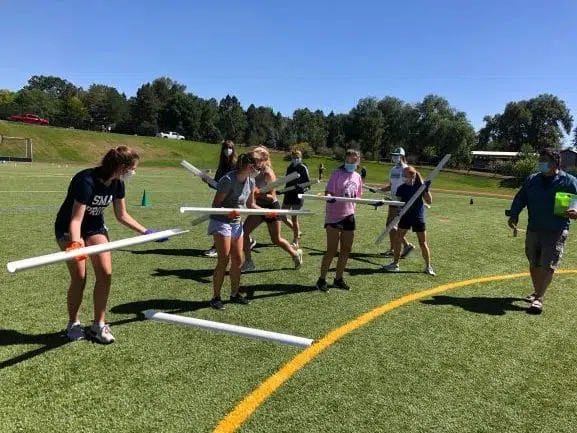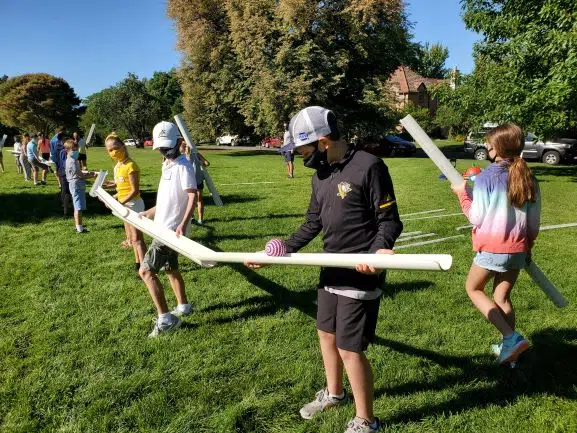During camp there will be many opportunities for children to work in small groups. This might be just one small group working by themselves, or it could be lots of kids split into groups all working on a task independently.
In more than a decade of working with children, I have tried hundreds of small group games, and the absolute best of these have made it into this article.
The ultimate 15 camp games for small groups are:
- Walk Of Life
- Can You Hear Me?
- Team Count With Eyes Closed
- Invisible Obstacle Course
- Wrapped Around My Finger
- Gutter Challenge
- Seven
- Dance Your Name
- Pied Piper
- Imaginary Ball
- Clap Jump Spin Run
- Ways To Move
- One Lion Rah!
- Pass The Noise With Eyes Closed
- Stop, Go!
These games are really focussing on team-building skills and cooperation. Lots of them also work well as icebreakers, or for teaching a range of other skills. Research shows the importance of teamwork on children’s cognitive skills and development. (Source)
So, let’s dive into the games:

1. Walk Of Life
This works well with a group anywhere between 3-6.
If you have lots of children, split them into groups, and then they will need their own space to complete the task.
The ‘Walk Of Life’ is a very personal tour through the life events of each member of the group.
One person goes first. That person will take between 6 big steps in a straight line. Each step represents one big event in their life. After each step they pause and tell the others the details of the event, before they move on to their next step.
So, for example, the first person might say, (step one) ‘I was born in Mississippi. My mum is a nurse, and my dad is a banker.’
Then step two, ‘When I was six my brother was born.’
Go through all kinds of life events – achievements, births, personal details – the whole lot.
The children often get really deeply engaged in this activity, and it can last for some groups over a long time period of twenty minutes or more.
2. Can You Hear Me?
This game is truly hilarious.
Three is the minimum of players for this game, and you can have up to about eight.
Two players stand facing each other, but about twenty yards apart.
The other players are going to stand in the middle between them (however many there are). There will be between 1 to 6 people in the middle (depending on how many you have in each group).
Pick some kind of theme for the game. It could be the names of films, or the names of food, or vehicles, or whatever else you like.
One of the two players on the outside of the formation is going to begin. If your theme was films, then this person is going to shout the name of a film to the other player.
However, the people in the middle are going to be trying to drown out the noise of the person speaking. They are going to be shouting, screaming, making silly noises, and trying to block the sight (and sound) of the person that they are communicating to.
As soon as the person manages to guess when film they are shouting, then go again, but this time with the person who was listening becoming the one shouting the film, and the shouter from before becoming the listener.
A great game for all sorts of tactics and just all-round fun!
3. Team Count With Eyes Closed
Again this works well for a team up to about six players.
The team sits or stands by themselves, and closes their eyes. The challenge is for them to try to count up in order, starting at ‘one’.
Only one person can say a number at a time. Also, you cannot go in order of where you are sitting (for example, around the circle).
If two people speak at the same time, then the team goes back to one. See how high you can go.
4. Invisible Obstacle Course
You need quite a wide space to play this game.
One person in the group is the leader to start with. They are going to imagine an invisible obstacle in front of the group. They are going to lead the way through, around, or over it.
Pretend obstacles could be things like stepping stones that you cross with balancing arms, crawling through a tunnel, or balancing over a tightrope.
Once you have had a good go of that person obstacle, another person in the team takes on the role of leader, and imagines the next obstacle.
Keep going across obstacles, and switching leaders as you go.
5. Wrapped Around My Finger
This is a great way of getting children to open up without the anxiety that often comes from that.
Have a long piece of string for each player in the team. They could potentially use a shoe lace instead.
One person goes first. They wrap their piece of string around their finger, as they talk about a certain theme.
They could talk about their hopes for the future, things they are proud of, things that make them happy, or whatever other theme you might think of.
The act of wrapping the string helps their mind to focus on that act, whilst talking at the same time. This lowers anxiety and stress, and gets children often to open up more about the theme under discussion.
I have seen this done also as an icebreaker with adults, and there is research that demonstrates the benefits of icebreakers with people of all ages. (Source)
6. Gutter Challenge
You need one piece of plastic gutter for every person in a team in this game.
This is a team challenge. Have one ball between each team (alongside the gutters).
Have one start point and an end point. The team must start with the ball balanced in one of the teams gutters at the start point. They must work together to make a channel of gutters and move the ball from the start point to the end point without the ball dropping the floor. You are not allowed to move your feet when the ball is in your gutter.
Players can move about with the gutters the rest of the time.

7. Seven
This is a counting game, where the children sit in a circle.
The idea is that you cannot say the number ‘seven’, or any numbers with a ‘seven’ in them (such as 17, 37 or anything like that).
You also cannot say any multiples of 7 – 14, 21 etc
When you come to a ‘seven’, two things happen – the player will clap, and also this resets the direction of the count.
So it goes a bit like, ‘1, 2, 3, 4, 5, 6, clap (and change direction), 8, 9, 10, 11, 12, 13, clap (and change direction), 15, 16, clap (change direction)’ etc
8. Dance Your Name
This is a great icebreaker, and also a good syllables game.
The idea of this is that each member of the group is going to think up a simple dance routine for their own name.
If, for example, your name was ‘Catherine’ you would have three syllables to dance to (with three dance moves). Your name in dance could look something like ‘Cath-’ (point both arms up), ‘-er-’ (both arms down), ‘-rine!’ (Do a star jump).
One at a time the players demonstrate their name dance, and the others copy.
They could try putting the whole group’s names into a sequence at the end.
9. Pied Piper
The idea of this game is that the group gets into a line behind one leader in the team.
That leader is the ‘Pied Piper’. They are going to lead the line around the space, and everyone is going to follow them.
The leader is going to move in all sorts of different ways, and the others will copy them.
For example, they could make their bodies really tall, or really small, they could walk backwards or sideways.
They could walk like an animal, or like a character (such as a giant). They could go fast, slow, and in any direction.
After two minutes another person can take over being the leader, and the games continues.
10. Imaginary Ball
Between three to eight players is great for this game.
They stand in a circle, and then one person imagines they are holding a pretend invisible ball. That person then throws the ball to the first person in the circle who pretends to catch it. They throw the ball to the next person, and keep going like this around the circle.
They can then extend this idea by being more imaginative with the methods of propelling the ball.
For example, they can head it, knee it, kick it, or use any other parts of their bodies to propel it to the next person.
This game can also be extended with the use of different imaginary objects.
Instead of throwing a ball, it could be a feather wafting in the air, or a balloon, or a bowling ball, or a cement block. All of these require different imaginary movements both to throw and catch.
11. Clap Jump Spin Run
This requires a team of about 5-8 players. They stand in a circle. Mark out a circle with cones, or something similar, and have one spare place that is unoccupied.
Then there is a process that repeats throughout the entirety of the game.
The first person ‘claps’ and then points at someone else.
That person ‘jumps’ then points at someone else. That person does a ‘360’ then points at next person. That person runs to the empty space.
Simply continue just like this.
12. Ways To Move
This is a really funny game that is good for imagination.
Between 4-8 players stand in a wide circle. Mark out the circle with cones again, and have one spare place.
One at a time, one person is going to cross the circle to the spare cone. That person is going to select a unique way to move. For example, they might pretend to ski across the circle.
Then another person will cross the circle, using another method. There is no order to follow – just whenever you have a good idea, then go for it, and take a trip across the circle.
Some other good ways to move include:
- Canoeing
- Moving like different animals
- A tightrope walker
- Hopping, jumping, skipping, slithering
The players can be as creative as they want.
13. One Lion Rah!
This is a fun game, with a bit of thinking and math thrown in.
This is a circle game for between 4-8 players. The first person in the circle says, ‘One lion’. The next person says how many eyes they would have – so in this case, ‘Two eyes.’
The next person says how many legs the lion would have, ‘Four legs.’ And the next person makes the noise that one lion would make – ‘Rah!’
The next player in the game would then move things on to, ‘Two lions.’ And it would go, ‘Four eyes.’ ‘Eight legs.’ ‘Rah! Rah!’ ‘Three lions.’ ‘Six eyes.’ ‘Twelve legs.’ ‘Rah! Rah! Rah!’
Continue until it becomes really difficult to continue.
14. Pass The Noise With Eyes Closed
This is quite an easy game, made much harder by the players closing their eyes.
It works well for teams of 4-8 players that will be stood or sitting in a circle.
One person is going to be the leader. They are going to be responsible for making up different noises. The noise is going to get ‘passed’ around the circle from person to person.
Good noises include:
- Animal noises like monkeys, lions, or cows
- Character voices, such as witches cackling, or ghosts going ‘woo!’
- Sound effects, like a firework going ‘pop’, or a pot going ‘ding!’
Of course you are doing all of this with eyes closed!
Do one revolution of each sound before moving on to the next game.
15. Stop, Go!
This is a game of movement, listening, and thinking all combined.
Players walk around a space in their team. The facilitator gives out several commands. These increase in difficulty as the game progresses.
Start with ‘stop’ and ‘go’. The players walk around the space in any direction. When the facilitator says ‘stop’ then the players stop. Pretty simple so far. And ‘go’ of course means go (walk).
The first way to mix things up is to make the words mean their opposite. So ‘stop’ becomes ‘go’, and ‘go’ becomes ‘stop’.
Have a go of this.
Then try introducing more commands. They could be ‘forwards’ and ‘backwards’, ‘left’, and ‘right’, ‘jump’ and ‘clap’.
Another extension is to try these versions of the games:
- Do the same and say the opposite
- Do the opposite and say the same
- Do the opposite and say the opposite
